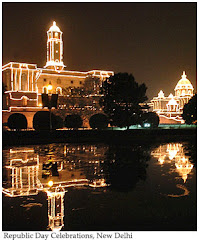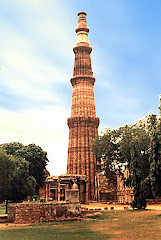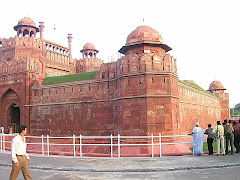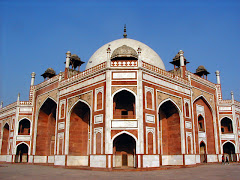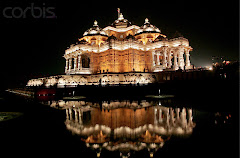Temples of Delhi
In an antique land like Delhi, the spirituality and devotion for the supreme self rises much higher than the soaring spires of old temples. The capital is dotted with serene temples that portray an impeccable blend of exquisite architecture and reverence, nestling under the shadow of evergreen trees. During the festive season,you can see hundreds of devotees hemming into offer their ovation,along with hundreds of coconuts,fragrant garlands and sweets. The temples are adorned with colorful lights that create a magnificent vista,glittering handsomely in the eyes of the devotees.
Birla Mandir
Birla Mandir also known as Laxmi Narayan Temple, it is ideally located in central delhi (Mandir Marg). This Temple which is dedicated to goddes of wealth,Laxmi and Narayana was built in 1938 by prominent Indian Industrialist Raja Bal Dev das Birla and inaugurated by Mahatma Gandhi. This Temple is built in Orrisa style and has man Idols representing various gods of Indian panthon.
Kalkaji Mandir
Situated beyond the commercial complex of Nehru Place this temple is dedicated to the Goddess Kalka Devi. Its oldest section dates back to 1764 and additions were made in the mid-19th century. However most of the building is modern thousands of pilgrims visit the temple specially in Octomber during the nine days of Navratras,when a huge fair is held here.
Chattarpur Mandir
One of the most popular hindu temples around Delhi,Chattarpur Mandir is located at a distance of four kilometer from Qutab Minar. The main temple is dedicated to Goddess Durga, while the devotees can also worship Shiva,Vishnu,Laxmi aur Ganesh in adjoining temples.During Durga puja days this place attractes a large number of devotees, who gather here to prayers. It is believed that tying a thread on a tree located in the temple premises will get the desired wishes fulfilled. It is a big temple complex that represents both South and North Indian style of architecture.
Iskcon Temple
Iskcon Temple is a complex of Temples which was Completed in 1998. Built on a hill place it is dedicated to the Lord Krishna and was built by the Hare Rama Hare Krishna cult followers. This complex is elegantly built and is one of the largest temple complexes in India. The main attractions of the temple are its central prayer hall and the temple museum. The festival of Janmashtami,the birth of Lord Krishna is celebrated here on a large scale.
Lotus Temple
It is a lotus shaped Temple Located in Kalkaji south of delhi, made up of marble,cement,dolomite and sand. It is open to all faiths and is an ideal place for meditation. It is a very recent architectural marvel of the Bahai faith,Bahai faith is the youngest of the world's independent religion. Fariborz Sahba, canadian architect of Iranian origin,spent 10 years in designing and project management,and with the help of a team of about 800 engineers,technicians,artisans and workers brought to realisation one of the most difficult construction of the world.
Bala Hanuman Temple
The elegant temple stands on the south-eastern side of Ranmal Lake. The 24 chanting of the Mantra 'Sri Ram,Jai Ram,Jai Jai Ram' which has been going in the temple since August 1,1964, has earned a place in the Guinness Books of world Records.
Akshardham Temple
The embrosial Akshardham Temple nesting on the banks of river yamuna over 100 acres of land, the Temple is a modern signature of exquisiote beauty. It is one of the biggest and most intricate religious of worship ever constructed. The temple affords a beautiful matrix of marble and Red Stone with many alluring sculptures that embellish its periphery.The temple is a desired fruit of 5 years of non stop and round the clock construction.
Aurobindo Ashramà
It is located on the south of Dehi near the Indian Institute of Technology on the road of Maharauli it has literature on the life of Sri Aurobindo and the mother and has an Ashram where devotees can come to meditate.
Gauri Shankar Temple
The 800 year old Gauri Shankar Temple is located next to the Digambar Jain Temple on the main Chandini chowk road. One of the most important temples of shaivism (a sector of Hiduism that worship Lord Shiva) in the country. It has an 800 year old brown lingam encased in a marble representation of a female organ,surrounded by snakes made of silver,the lingam according to Hinduism represents a 'cosmic pillar,the center of universe,the life it self'. The auspicious day to visit the temple is Monday as it is considered to be the day of Lord Shiva.
Kali Bari Mandir
A stones through from Birla Mandir to the right is the much smaller but quite popular temple devoted to the Goddess Kali. Especially dear to the bengali community of delhi,Kali Bari Mandir in delhi is the centre of celebration during the festival of Durga Puja
Wednesday, September 12, 2007
Wednesday, September 5, 2007
Jantar Mantar ( New Delhi)

Jantar Mantar is one of the famous attraction in Delhi. It draws a stream of visitors all around the year. Jantar Mantar was built in 1710 by Raja Jai Singh II of Jaipur (1699-1743) in Delhi. Jantar Mantar is one of the world’s oldest astronomical observatories monument. This monument gives a deep insight into the technological innovations of the time and is an integral part of India’s scientific heritage. Jantar Mantar at Delhi is located on Sansad Marg between Cannaught place and Rashtrapati Bhavan. It is the largest and best preserved as compared to the other four open air observations which were built by Sawai Jai Singh in Jaipur,Varanasi, Mathura and Ujjain.
Architecture and it’s Significance:
The whole structure is made up of stone and marble with each of them having an engraved astronomical skill. It is a remarkable structure which consists of fourteen geometric devices used for measuring time, forecasting weather changes, predicting behavior of planets and finding extraterrestrial altitude. All these devices are of fixed structures and point to a fixed direction. Some of the major instruments at Jantar Mantar are The Samrat yatra: it is the tallest is 90 feet high it’s shadow carefully plotted to tell the time of the day. It’s face is angled at 27 degrees,the Ram yantra, The Jay Prakash, The Misra Yantra (north west to the Samrat yantra) used to measure the shortest and longest day of the year,. The Hindu Chatri on the top is used as a platform for announcing eclipses and the arrival of monsoons. The Jantar Mantar finally got the status of a National Monument in 1948. It has always attracted architects, historians and scientists from all over the world.
Nearby Attractions:
The other tourist attractions nearby Jatar Mantar are Rastrapathi Bhavan: it is the house of the President of India. It is perhaps India’s best known moument after the Taj Mahal and Qutab Minar bigger than the palace of Versailles. India Gate: India Gate which was Built as a memorial to commemorate the 70,000 Indian soldiers killed in world war I, India Gate was designed by Sir Edwin Lutyens and completed in 1931. Gurudwara Bangla Sahib: It is one of the most popular place of worship in Delhi. The gurudwara is built on the site of a house where Guru Harkishan Dev the eighth guru of the sikhs has stayed when he visited Delhi in 1664. By hiring an auto rickshaw you can visit these places within the time frame of ten to fifteen minutes or you can take the services of a Guide to make your walk more simple.
Places to Eat:
The nearby restaurants where you can enjoy a good Indian meal with your family Parikrama rivolving reataurant, Gay lord, Zen restaurant, Delhi Darbar, Nizams Kathi Kababs etc. For Snacks & Fast foods you can visit Bengali Market for Indian Sweets and innumerable Roadside food stalls.
Nearby Shopping Places:
The nearby shopping venues from Jantar Mantar are Cannaught Place: It was built in 1931 and It is one of the most popular shopping spot of Delhi there is nothing that one cannot buy here and it also has several eating houses. The state emporium buildings is also located in this area so are the head offices of major banks, airlines, and other such things of importance to the tourist.Central Cottage Industrial Emporium which has Indian Handicrafts curios. Janpath which offers clothes, low priced gifts and souvenirs and Palika Bazar which offers a wide range of Electronic items.
Nearby Shopping Places:
The nearby shopping venues from Jantar Mantar are Cannaught Place: It was built in 1931 and It is one of the most popular shopping spot of Delhi there is nothing that one cannot buy here and it also has several eating houses. The state emporium buildings is also located in this area so are the head offices of major banks, airlines, and other such things of importance to the tourist.Central Cottage Industrial Emporium which has Indian Handicrafts curios. Janpath which offers clothes, low priced gifts and souvenirs and Palika Bazar which offers a wide range of Electronic items.
Sunday, September 2, 2007
Red Fort/Lal Quila
Lal Quila is the largest of the Old Delhi’s monuments. It is situated on the western bank of the river yamuna forms the majestic centerpiece of Mughal Emperor Shahjahans medieval walled city Shahjahanabad (Old Delhi).
The Lal Quila rises above a wide dry moat,in the north east corner of the original city of shahjahanabad. Lal Quila is the eloquent reminder of the glory of Mughal era, and its magnificance simply leaves one awestruck.
Architecture
The Mughal Emperor Shahjahan started the construction of the massive fort in 1638, and work was completed in 1648. Its walls extends upto two kilometers, and vary in height from 18 meters from the river side to 33 meters on the city side. The main entrance opens on to the chatta chowk, a covered street flanked with arched cells.The fort also houses the Diwan-i-amor the hall of public audiences where the emperor would sit and here the complaint of the common folks. The other attractions enclosed within this monuments are the hammams or the Royal Baths, the shahi Burj which used to be shahjahans working area, and the moti masjid or the pearl mosque built by Aurangzeb for his personal use.
How to reach
The Red Fort is situated in Netaji Subhash Marg near chandini chowk in old delhi.Tourists can take local buses, auto rikshaw,taxi or metro rail(if possible) to Red fort.
Special Events
Every Year on the 15th of August the National Flag of India is hoisted at the Red Fort by the Prime Minister, celebrating India’s Independence.
Sound & Light show
There is a one hour sound and light show in hindi and english every day except Mondays showcasing history of Delhi and Lal Quila.
Timings:
September & Octomber
7.00 to 8.00 pm (English)
8.30 to 9.30 pm (Hindi)
November to January
6.00 to 7.00 pm (English)
7.30 to 8.30 pm (Hindi)
February to April
7.00 to 8.00 pm (English)
8.30 to 9.30 pm (Hindi)
May to August
7.30 to 8.30 pm (English)
9.00 to 9.30 pm (Hindi)
Entry fees Rs.50/- for adult and Rs.20/- for childeren
Shopping
you will enter into the fort you will find a vaulted arcade,famous as the chatta chowk.The restless shops in this arcades use to sell upmarkets artafects that the royal blood may fancy. You can also do shopping in chandini chowk which is just opposite to Lal Quila it is famous for its saree market, you will find variety of sarees in different ranges.
Nature Walk
You can simply stroll around in and around the monument and you can take the services of a Guide to make your walk more simple or you can hire a cycle rickshaw to visit the near by markets specially Chandini Chowk.
The Lal Quila rises above a wide dry moat,in the north east corner of the original city of shahjahanabad. Lal Quila is the eloquent reminder of the glory of Mughal era, and its magnificance simply leaves one awestruck.
Architecture
The Mughal Emperor Shahjahan started the construction of the massive fort in 1638, and work was completed in 1648. Its walls extends upto two kilometers, and vary in height from 18 meters from the river side to 33 meters on the city side. The main entrance opens on to the chatta chowk, a covered street flanked with arched cells.The fort also houses the Diwan-i-amor the hall of public audiences where the emperor would sit and here the complaint of the common folks. The other attractions enclosed within this monuments are the hammams or the Royal Baths, the shahi Burj which used to be shahjahans working area, and the moti masjid or the pearl mosque built by Aurangzeb for his personal use.
How to reach
The Red Fort is situated in Netaji Subhash Marg near chandini chowk in old delhi.Tourists can take local buses, auto rikshaw,taxi or metro rail(if possible) to Red fort.
Special Events
Every Year on the 15th of August the National Flag of India is hoisted at the Red Fort by the Prime Minister, celebrating India’s Independence.
Sound & Light show
There is a one hour sound and light show in hindi and english every day except Mondays showcasing history of Delhi and Lal Quila.
Timings:
September & Octomber
7.00 to 8.00 pm (English)
8.30 to 9.30 pm (Hindi)
November to January
6.00 to 7.00 pm (English)
7.30 to 8.30 pm (Hindi)
February to April
7.00 to 8.00 pm (English)
8.30 to 9.30 pm (Hindi)
May to August
7.30 to 8.30 pm (English)
9.00 to 9.30 pm (Hindi)
Entry fees Rs.50/- for adult and Rs.20/- for childeren
Shopping
you will enter into the fort you will find a vaulted arcade,famous as the chatta chowk.The restless shops in this arcades use to sell upmarkets artafects that the royal blood may fancy. You can also do shopping in chandini chowk which is just opposite to Lal Quila it is famous for its saree market, you will find variety of sarees in different ranges.
Nature Walk
You can simply stroll around in and around the monument and you can take the services of a Guide to make your walk more simple or you can hire a cycle rickshaw to visit the near by markets specially Chandini Chowk.
Qutub Minar
The word Qutab Minar means Axis minaret. Qutab Minar the 239ft sandstone tower is an indo-islamic architectural wonder of ancient India.
The tower which dominates the country side for miles around has five storeys, each marked by a projected balcony.It is the tallest brick minaret in the world., and an important example of indo-islamic agriculture.The Qutab Minar and its monuments are listed as a UNESCO world heritage. Qutab-Ud –Din Albek commenced building Qutab Minar in 1199A.D and it was completed by sultan’s successor and son in law,lututmish. The magnificent tower of victory stands in Qutab Complex located in Aurobindo Marg, near Mahrauli, 14km from Cannaught Place. The best time to visit is October to March.
Architecture
The Qutab Minar is 72.5 cm high (237.8 ft) and requires 399 steps to get to the top. The diameter of the base is 14.3 meters wide and the top floors measures 2.75 meters. The first three storeys are made of red sandstone and are heavily indented with different styles of fluting, alternatively round and angular on the bottom floor, round on the second and angular on the third. The fourth and fifth floors are made of marble and sandstone.
Things To Do :
Special Events:
Many events such as Cultural shows, Drama shows and various exibitions are organised for Tourists in which many celebrities from different fields participate, you can experience a wonderful moment by watching or participating in these events.
Photography:
You can capture some unique frames of this historical monument with your loved ones for your unforgetable memories.
SHOPPING and Eating:
Apart from sight seeing you can enjoy the experience of foot path or road side shopping of clothes,accessories,artificial jwelleries etc with good street foods like chole bhature,dosa,idli etc you will find a mini India on the footpaths of Delhi.
Nature walk :
You can simply stroll around the near by park and you can take the services of a Guide to make your walk more simple or you can hire a cycle rickshaw to visit the near by markets.
The tower which dominates the country side for miles around has five storeys, each marked by a projected balcony.It is the tallest brick minaret in the world., and an important example of indo-islamic agriculture.The Qutab Minar and its monuments are listed as a UNESCO world heritage. Qutab-Ud –Din Albek commenced building Qutab Minar in 1199A.D and it was completed by sultan’s successor and son in law,lututmish. The magnificent tower of victory stands in Qutab Complex located in Aurobindo Marg, near Mahrauli, 14km from Cannaught Place. The best time to visit is October to March.
Architecture
The Qutab Minar is 72.5 cm high (237.8 ft) and requires 399 steps to get to the top. The diameter of the base is 14.3 meters wide and the top floors measures 2.75 meters. The first three storeys are made of red sandstone and are heavily indented with different styles of fluting, alternatively round and angular on the bottom floor, round on the second and angular on the third. The fourth and fifth floors are made of marble and sandstone.
Things To Do :
Special Events:
Many events such as Cultural shows, Drama shows and various exibitions are organised for Tourists in which many celebrities from different fields participate, you can experience a wonderful moment by watching or participating in these events.
Photography:
You can capture some unique frames of this historical monument with your loved ones for your unforgetable memories.
SHOPPING and Eating:
Apart from sight seeing you can enjoy the experience of foot path or road side shopping of clothes,accessories,artificial jwelleries etc with good street foods like chole bhature,dosa,idli etc you will find a mini India on the footpaths of Delhi.
Nature walk :
You can simply stroll around the near by park and you can take the services of a Guide to make your walk more simple or you can hire a cycle rickshaw to visit the near by markets.
Subscribe to:
Posts (Atom)
